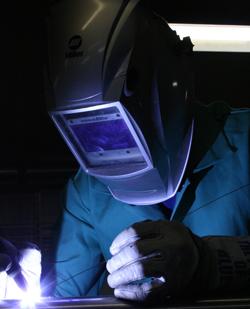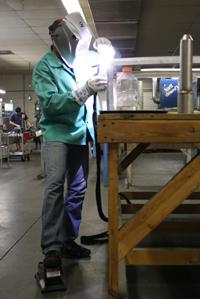Marketing Manager
- FMA
- The Fabricator
- FABTECH
- Canadian Metalworking
Categories
- Additive Manufacturing
- Aluminum Welding
- Arc Welding
- Assembly and Joining
- Automation and Robotics
- Bending and Forming
- Consumables
- Cutting and Weld Prep
- Electric Vehicles
- En Español
- Finishing
- Hydroforming
- Laser Cutting
- Laser Welding
- Machining
- Manufacturing Software
- Materials Handling
- Metals/Materials
- Oxyfuel Cutting
- Plasma Cutting
- Power Tools
- Punching and Other Holemaking
- Roll Forming
- Safety
- Sawing
- Shearing
- Shop Management
- Testing and Measuring
- Tube and Pipe Fabrication
- Tube and Pipe Production
- Waterjet Cutting
Industry Directory
Webcasts
Podcasts
FAB 40
Advertise
Subscribe
Account Login
Search
Specialty fabricator goes wireless with GTAW foot pedals
Improves productivity and safety, reduces equipment costs
- By Brent Williams
- October 4, 2010
- Article
- Arc Welding
Welders often are restricted by the length and cumbersome nature of cords, wires, and lead required to lay a weld. These elements restrict movement around weld cells, clutter the floor, and create impediments to safety and productivity. Wireless gas tungsten arc welding (GTAW) foot controls can help eliminate the hassle and reduce cost while improving safety.
Foot pedals are a common and effective method of controlling amperage for GTAW. A major limitation to mobility and a common source of failure is the remote control cord that connects the remote to the power source. While remote controls offer an advantage by allowing welders to make on-the-fly adjustments, the cord itself gets tangled around weld tables, chairs, and fixtures, making it difficult for the welder to reposition around the workpiece. Wireless remotes can:
- Allow welders to reposition the remote quickly and easily around the weld without having to untangle cords.
- Eliminate problems with remote control cords, such as wear and failure, and reduce associated downtime and replacement costs.
- Enhance weld cell safety by reducing clutter and eliminating a tripping hazard.
An early adopter of wireless remote GTAW foot controls is RAFAB Specialty Fabrication, Orlando, Fla. The company reportedly has found the technology to be as responsive and accurate as hard-wired remotes while extending the welding range well beyond the typical 20-ft. length of the remote control cord.
A Pedal as Mobile as a Welder
With a variety of amusement parks and military installations located near RAFAB’s shop, owner Rick Arnold and his team see a wide variety of projects come through: brackets for recumbent bikes, simulators for Army helicopters, and specialized designs for local resorts and attractions. Arnold and his team of precision gas tungsten arc welders rely on a fleet of new inverters, old transformers, and every type of torch and cup imaginable to make intricate welds on one-of-a-kind aluminum and specialty alloy components. One piece of equipment, however, has always been a headache.
“We’ve always been fighting over the cord, getting tripped up in it or dropping a piece of metal on it and wrecking it,” said Arnold. “Having a pedal without a remote control cord that is as mobile as you is extremely helpful.”
The concept is simple: A wireless receiver plugs into the 14-pin receptacle of the welding machine in the same manner as a corded pedal. The pedal and receiver are linked together right out of the box, which makes installation quick and simple. Each pedal has a unique address that eliminates any chance of cross-talking between pedals/machines, and pedals are easily relinked if switched. Multiple frequency sharing allows up to 20 pedals to be used within a 90-ft. radius without interference.
“I’ve got three jobs going at the same time and I’ll bounce back and forth between three work areas,” said Arnold. “They’re all within 20 feet of each other, but there are all kinds of legs and obstructions in the way. Eliminating [cords has been] huge. With the economy the way it is, I have to make up 12 to 15 percent somewhere. If I can help do it with this [wireless remote], that’s great.”
RAFAB’s overall savings comes from easier repositioning around the welding benches (increased productivity) and the cost savings from not having to replace or repair broken remote control cords all the time. Many fabricators, like Arnold, find the cost of repairing the cord alone to be too high and simply replace the whole ensemble.
“If I have a choice between putting $180 into fixing a cord and pedal or spending $240 on a new one, I’ll just get a new one and be done with it,” said Arnold. “We’ve always kept two spares, but there were times when we’d go through both of them and damage a third within a couple of days. Overall lifespan of a pedal in my shop is four months [because of the damage done to the cord]. If we went through three a year, that’s $720 in pedals per machine, and I have five machines.”
Improved Safety
Arnold reported that the wireless pedal also improved safety as a wireless remote offers one less tripping hazard in his shop.
“The kind of cable that is on the back of [nonwireless GTAW] pedals has a tendency to spiral up and not sit flat on the floor if it has been wound up too tightly and put in a condensed place. That does me no good and is a safety hazard.”
No Interference
Arnold also said that the response time and effectiveness of the pedals are identical to those of a corded pedal and that he has never had problems with interference, either between other pedals or other equipment, since he’s added the wireless models.
“There’s no difference compared to the hard-wired pedals,” said Arnold. “No delay, no snags, no spikes.”
One Less Opportunity for Contamination
Having a pedal that he can kick from place-to-place without having to pick it up or manually untangle cords also eliminates a prime opportunity for contaminants to transfer from the floor to the glove to the filler rod.
“You can’t feed wire through gloves that are filthy,” he said, “and you can’t pass certification if you’ve got goop all over your gloves. That cable lies in the stuff we’re welding and grinding all day. If they get that stuff embedded in their gloves then they get it embedded in the weld zone, I’ve got a junk part. All of our welding rod is kept in sealed tubes. We do all the little things to make sure the wire is clean, so not having to pick up the remote is a big thing for us.”
About the Author
Brent Williams
1635 W. Spencer St. P.O. Box 1079
Appleton, WI 54912
800-426-4553
About the Publication
Related Companies
subscribe now

The Welder, formerly known as Practical Welding Today, is a showcase of the real people who make the products we use and work with every day. This magazine has served the welding community in North America well for more than 20 years.
start your free subscription- Stay connected from anywhere

Easily access valuable industry resources now with full access to the digital edition of The Fabricator.

Easily access valuable industry resources now with full access to the digital edition of The Welder.

Easily access valuable industry resources now with full access to the digital edition of The Tube and Pipe Journal.
- Podcasting
- Podcast:
- The Fabricator Podcast
- Published:
- 04/16/2024
- Running Time:
- 63:29
In this episode of The Fabricator Podcast, Caleb Chamberlain, co-founder and CEO of OSH Cut, discusses his company’s...
- Industry Events
16th Annual Safety Conference
- April 30 - May 1, 2024
- Elgin,
Pipe and Tube Conference
- May 21 - 22, 2024
- Omaha, NE
World-Class Roll Forming Workshop
- June 5 - 6, 2024
- Louisville, KY
Advanced Laser Application Workshop
- June 25 - 27, 2024
- Novi, MI


































